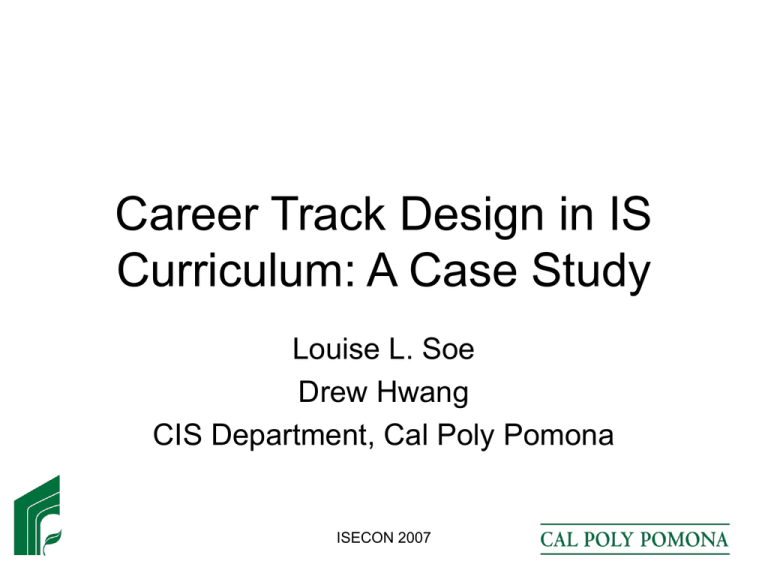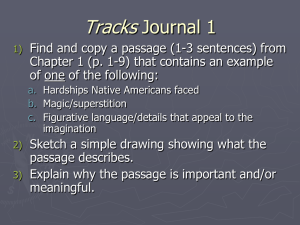Career Track Design in IS Curriculum: A Case
advertisement

Career Track Design in IS Curriculum: A Case Study Louise L. Soe Drew Hwang CIS Department, Cal Poly Pomona ISECON 2007 Curriculum Redesign Case Study • Who we are • Background • Research into Curriculum Change – Model Curricula – IS Career Track Database • Our Curriculum Analysis • Decision making ISECON 2007 Who we are • Southern California Polytechnic University – “learn by doing” is school motto – CIS major classes are taught hands-on, projects • CIS self identity tied up with curriculum innovation • Our faculty had beeen early leaders in differentiation of business information systems from CS (70s & 80s) • Career tracks began in 1980, and were important to our curriculum & to our self-identity ISECON 2007 Recent Developments • Founders of department had retired • Drop in number of majors (from 1300+ in 1998 to 550 in 2006) – NOTE: We initiated reduction by increasing standards in 1999 to bring enrollments down. • System-wide reduction in number of quarter units to graduation from 195 to 180 • Pressures of AACSB re-accreditation on college ISECON 2007 Recent Developments • CIS had developed a strong security program, building on existing MSMBA IS Auditing program – With NSF grant support – Collaboration with Carnegie Mellon Information Assurance Capacity Building Program • The National Security Agency & the Department of Homeland Security recognized the Cal Poly CIS program as a “Center of Academic Excellence”. – only 3 schools in California have this distinction. – The other 2 are UC Davis & the Naval Postgraduate School in Monterey. ISECON 2007 The process • Fall 2006 – Faculty decided we needed a to review curriculum • Gathered information on model curricula – IS 2002, CC 2005, IT 2005 • Reviewed curricula of 490 IS, MIS, CIS baccalaureate programs in U.S. business schools to see where we stand – Built database to hold information ISECON 2007 Findings: Career Tracks throughout U.S. • • • • 96 programs had total of 269 career tracks Numbers of tracks ranged from 2-13 No consistency in track names Almost all career tracks are named after disciplines & sub-disciplines; very few named after jobs. • It appears that faculty don’t look at a model, but craft track names that mean something to their consistencies & help their students get jobs ISECON 2007 More findings • No consistency on the definition of what constitutes a career track: – Numbers of courses varied – • further complicated by fact many program definitions of a track only included the final 2-3 courses • others listed the student’s entire degree requirements from beginning to end. – No consistency in choice of specific courses that belonged in career tracks with same/similar names – Track structures ranged from highly structured to completely unstructured (i.e., individually designed by student & advisor). – Track courses ranged from entirely within the major department to entirely outside the major department ISECON 2007 Number of tracks in program Frequency of Programs Percent of total with tracks: N=96 Programs 1 15 16% 2 36 38% 3 25 26% 4 9 9% 5 5 5% 6 2 2% 7 2 2% 8 1 1% 9 0 0% 10 0 0% 11 0 0% 12 1 1% Totals 96 100% ISECON 2007 70% Track Categories in 96 schools • Applications Development (49) • IS Disciplines (IS, MIS, CIS, CS, IT) (41) • Web technologies/ E-commerce (38) • Networking/ Telecommunications (33) • Information Assurance (25) • Business/Systems Analysis (19) • Business Functional Applications (19) • Information Management (15) • Specialized IS/Studies (14) • End User Support/ Training (8) • Decision Support Systems (8) ISECON 2007 Our Curriculum in Fall 2006 • Students earn a B.S. degree in Business with concentration in Computer Information Systems • Business core: 12 4-unit courses • 8 CIS core courses-- have to get C or better in 2 tries: – – – – – – – 2 Java programming courses Intro to object-oriented systems analysis & design Telecommunications Database design & Development Web development IS careers – gateway to tracks Senior project – capstone course after 3 track courses completed • 4 career tracks – take 4 courses; 4th can be 2 unit internship or special studies or a 4-unit track course – – – – Application & Systems Development Internet Programming & Security Business Systems Analysis Telecommunications ISECON 2007 At End of Fall Quarter • One-day faculty retreat to review curriculum – Compared core courses to model curricula • IS 2002 – compared favorably in terms of body of knowledge • IT 2005 – not comparable – consensus that we did not have faculty resources to adopt this model, however attractive it is – Compared our track courses to career tracks of other schools in database • We were OK, but no longer out in front ISECON 2007 By the end of the retreat … • Decided to leave core alone – Had been complete reorganized in 1995 to adopt object orientation – Had been tweaked ever since to strengthen body of knowledge students had at graduation – Almost all students had IT internship • Decided to examine the career tracks and align them with developments in the field – Programming classes had moved to web interface – Strong growth in security area ISECON 2007 Results Scrapping career tracks was discussed but proved too foreign to department’s culture Committee developed 3 career track proposals: 1. Cafeteria model: students design own tracks with advising 2. Cluster model: students pick clusters of 2-3 courses & build own track, with advising 3. Reform current track realignment (incremental): – – – – Information Assurance (Security, Computer Forensics, Secure Web Computing, IS Auditing) Application development merges with web/e-commerce courses & multimedia course (which provides usability & accessibility components) Business Systems Analysis (includes RAD) Telecommunications & Networking ISECON 2007 Decisions in Spring 2007 • One faculty member presented each option & the arguments for and against it. • Lots of discussion and switching decisions – Everyone enjoyed the meeting – the level of give & take was high • In the end, the faculty reached consensus on keeping the tracks & realigning them • Changes in track structure are being implemented in January 2008 ISECON 2007 Conclusions • We are in minority (25%) of programs with career tracks • Our tightly structured program is demanding on faculty resources • The process of re-examining our curriculum was an important activity for us • We needed to adapt to the changes in the field. ISECON 2007 Recommendations • Periodic review of curriculum is healthy • The current effort of ACM & to create a model career track curriculum is sorely needed: – definition of what a career track is – Some consistency in track names – Consistency in courses required for track – Still using job names rather than subdiscipline names that we found almost everywhere • List on next slide ISECON 2007 Current AIS/ACM Wiki List of Tracks http://blogsandwikis.bentley.edu/iscurriculum/index.php/Career_tracks • Application Developer • Business Intelligence Manager • Business Process Analyst • Database Administrator • Database Analyst • eBusiness Manager • ERP Specialist • Information Auditing and Compliance Specialist • IT Architect • IT Asset Manager • IT Consultant • IT Operations Management Specialist • IT Security and Risk Manager • Network Design and Administration Specialist • Project Manager • User Interface Designer • Web Content Manager ISECON 2007






